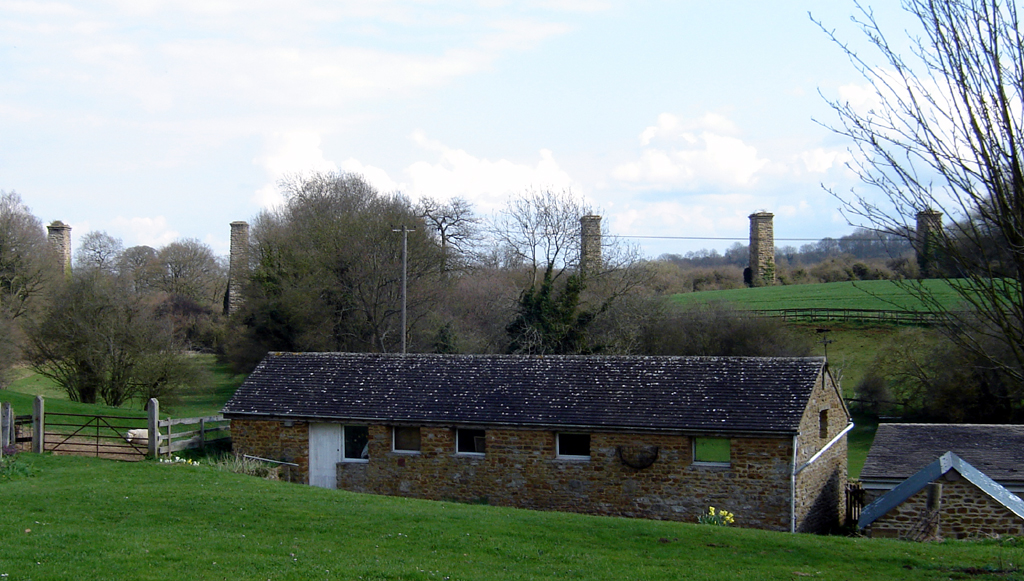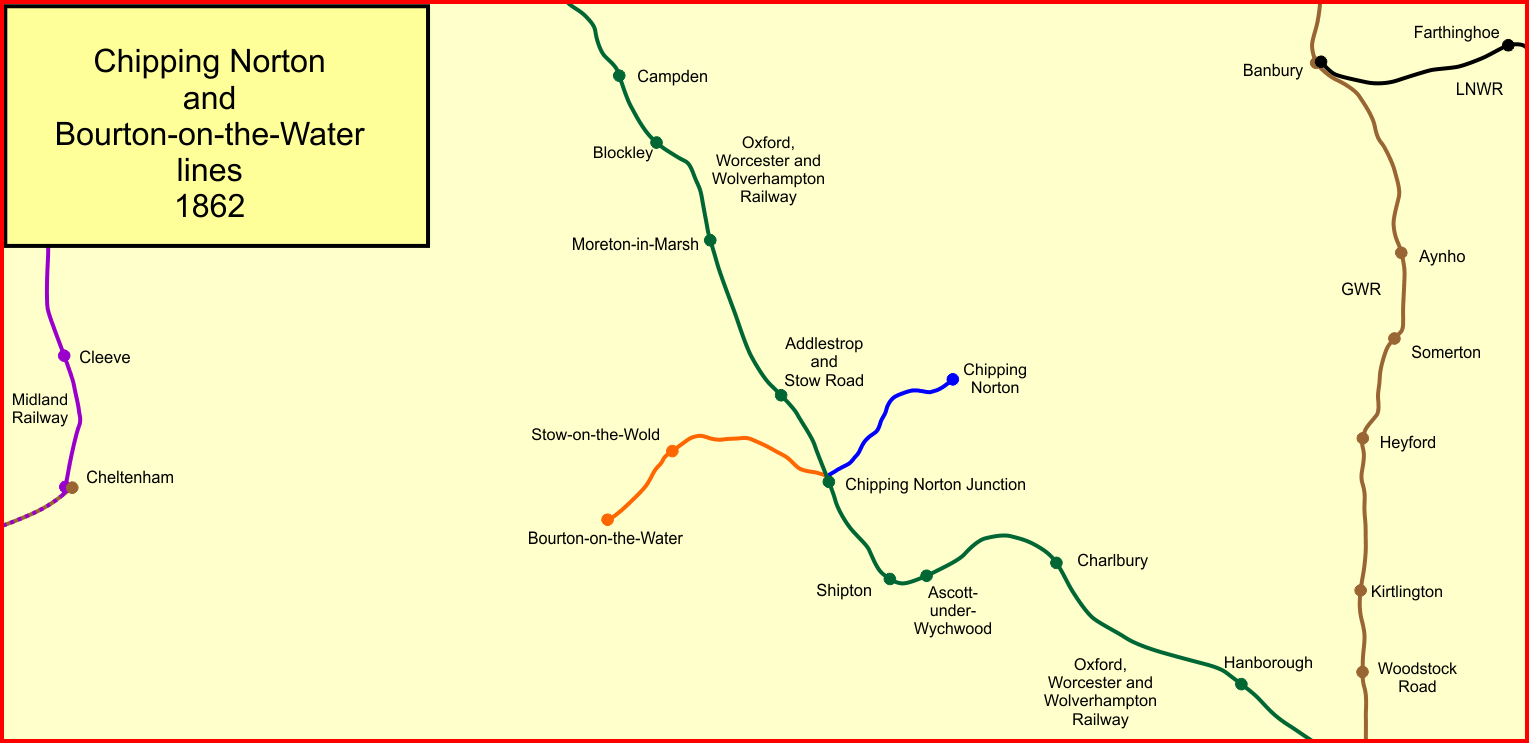|
Rollright Halt Railway Station
Rollright Halt railway station served the village of Great Rollright in Oxfordshire, England. History The station was built by the Great Western Railway. Local residents had campaigned for a station to serve Great Rollright since 1875. When Britain's railways were nationalised in 1948 the B&CDR became part of the Western Region of British Railways. In 1951 British Railways withdrew passenger services from the line through Rollright Halt. In 1962 BR closed the railway to freight traffic and some time thereafter the line was dismantled. Rollright Siding On 1 January 1909 a goods siding was opened 200 yards east of the passenger halt. A small platform and corrugated iron goods shed were provided. Incoming traffic was mostly coal for the local merchant James Taplin and also for Nash's of Long Compton. Outgoing traffic included pheasants and sugar beet A sugar beet is a plant whose root contains a high concentration of sucrose and which is grown commercially for sugar prod ... [...More Info...] [...Related Items...] OR: [Wikipedia] [Google] [Baidu] |
Great Rollright
Great Rollright is a village in the civil parish of Rollright, about north of Chipping Norton, Oxfordshire. Archaeology The megalithic Rollright Stones are about west of Great Rollright, near the Warwickshire village of Long Compton. Parish church The Church of England parish church of Saint Andrew has Norman, Early English, Decorated Gothic and Perpendicular Gothic features. St Andrew's was restored in 1852 under the direction of the Oxford Diocesan Architect, GE Street. St Andrew's is a Grade I listed building. The west tower has a ring of six bells. William Bagley of Chacombe, Northamptonshire cast the fourth, fifth and tenor bells in 1695 and the third bell in 1696. W&J Taylor cast the second bell in 1839, presumably at the foundry they then had at Oxford. Henry I Bond and Sons of Burford cast the treble bell in 1899. St Andrew's parish is now part of the Benefice of Hook Norton with Great Rollright, Swerford and Wigginton. On the 23 December 1944, a U ... [...More Info...] [...Related Items...] OR: [Wikipedia] [Google] [Baidu] |
Hook Norton
Hook Norton is a village and civil parish in Oxfordshire, England. It lies northeast of Chipping Norton, close to the Cotswold Hills. The 2011 Census recorded the parish's population as 2,117. The village is formed of four neighbourhoods: East End, Scotland End (in the west), Down End (in the centre) and Southrop (in the south). Toponymy In the ''Anglo-Saxon Chronicle'' in 917 the village is recorded as ''Hocneratun''. The Domesday Book of 1086 records it as ''Hochenartone''. A charter from 1130 records it as ''Hokenartona''. An episcopal register entry from 1225 records it as ''Hokenartone''. A record from 1267 records it as ''Hokenarton''. The ''Taxatio Ecclesiastica'' of 1291 records it as ''Hoke Norton''. Other past spellings of the name include ''Hocceneretune'' (1050), ''Hogenarton'' (1216) and ''Okenardton'' (1263). ''Hegnorton'' is recorded in a plea roll from 1430. The name is derived from Old English. ''Hocca'' may perhaps be the name of a person or tribe, altho ... [...More Info...] [...Related Items...] OR: [Wikipedia] [Google] [Baidu] |
Former Great Western Railway Stations
A former is an object, such as a template, gauge or cutting die, which is used to form something such as a boat's hull. Typically, a former gives shape to a structure that may have complex curvature. A former may become an integral part of the finished structure, as in an aircraft fuselage, or it may be removable, being using in the construction process and then discarded or re-used. Aircraft formers Formers are used in the construction of aircraft fuselage, of which a typical fuselage has a series from the nose to the empennage, typically perpendicular to the longitudinal axis of the aircraft. The primary purpose of formers is to establish the shape of the fuselage and reduce the column length of stringers to prevent instability. Formers are typically attached to longerons, which support the skin of the aircraft. The "former-and-longeron" technique (also called stations and stringers) was adopted from boat construction, and was typical of light aircraft built unti ... [...More Info...] [...Related Items...] OR: [Wikipedia] [Google] [Baidu] |
The Railway Magazine
''The Railway Magazine'' is a monthly British railway magazine, aimed at the railway enthusiast market, that has been published in London since July 1897. it was, for three years running, the railway magazine with the largest circulation in the United Kingdom, having a monthly average sale during 2009 of 34,715 (the figure for 2007 being 34,661). It was published by IPC Media until October 2010, with , and in 2007 won IPC's 'Magazine of the Year' award. Since November 2010, ''The Railway Magazine'' has been published by Mortons of Horncastle. History ''The Railway Magazine'' was launched by Joseph Lawrence and ex-railwayman Frank E. Cornwall of Railway Publishing Ltd, who thought there would be an amateur enthusiast market for some of the material they were then publishing in a railway staff magazine, the ''Railway Herald''. They appointed as its first editor a former auctioneer, George Augustus Nokes (1867–1948), who wrote under the pseudonym "G. A. Sekon". He quickly ... [...More Info...] [...Related Items...] OR: [Wikipedia] [Google] [Baidu] |
Banbury And Cheltenham Direct Railway
The Banbury and Cheltenham Direct Railway (B&CDR) was a railway company through the Cotswolds in England that built a line between points near Banbury and Cheltenham. Its principal objective, as well as a general rural rail service, was the conveyance of iron ore from the East Midlands to South Wales. It extended two pre-existing branches, the branch of the Oxford, Worcester and Wolverhampton Railway (OW&WR, opened in 1855) and the Railway (opened in 1862). Both branches had their main line junction at Chipping Norton Junction, later renamed , on the OW&WR main line. The B&CDR opened its western section, from Bourton-on-the-Water to a junction near Cheltenham, in 1881, and its eastern section, from Chipping Norton to a junction at , near Banbury, in 1887. The company was always short of money, and the timescale of construction was correspondingly lengthy. When the extensions opened, the Great Western Railway worked the B&CDR line and the two earlier branches as a single railwa ... [...More Info...] [...Related Items...] OR: [Wikipedia] [Google] [Baidu] |
Hook Norton Railway Station
Hook Norton railway station served the village of Hook Norton in northern Oxfordshire, England. History The station was built for the Banbury and Cheltenham Direct Railway, which was operated by the Great Western Railway before complete takeover in 1897. Following the passing of the Act of Parliament in 1873 authorising the construction of the B&CDR, it was announced in 1874 that a station would be provided at Hook Norton. The location originally proposed was north of the Milcombe Road and a start had been made on construction at this site but this was abandoned in 1883 in favour of a site to the south, slightly nearer the village. On 2 June 1884 it was reported that "Hook Norton Station is built nearly up to the level of the doors". The entire station and goods yard were built on a large embankment containing 120,000 cubic yards of earth, which led onto the first of Hook Norton's two viaducts. In order to provide solid foundations, the platforms were supported on iron girders ... [...More Info...] [...Related Items...] OR: [Wikipedia] [Google] [Baidu] |
Chipping Norton Railway Station
Chipping Norton railway station served the town of Chipping Norton, Oxfordshire, England. The station had two platforms and a signal box. History The station was opened in 1855 as the terminus of the Chipping Norton Railway, which linked the town to the Oxford, Worcester and Wolverhampton Railway by a junction at . The line was promoted by William Bliss and its traffic included freight to and from his tweed mill at Chipping Norton. Goods trains started running to the station in June 1855 and the official opening to passengers took place on 10 August 1855. Initially there were three trains each way, but by January 1856 this had increased to six each way, the first and last of which continued along the main line to . The station comprised a single platform and two-storey building. No photographs exist, but Bliss Tweed publicity material includes drawings of the station. A single-road engine shed, water tank and goods shed were also provided. Following complaints by passengers o ... [...More Info...] [...Related Items...] OR: [Wikipedia] [Google] [Baidu] |
Sugar Beet
A sugar beet is a plant whose root contains a high concentration of sucrose and which is grown commercially for sugar production. In plant breeding, it is known as the Altissima cultivar group of the common beet ('' Beta vulgaris''). Together with other beet cultivars, such as beetroot and chard, it belongs to the subspecies ''Beta vulgaris'' subsp. ''vulgaris.'' Its closest wild relative is the sea beet (''Beta vulgaris'' subsp. ''maritima''). Sugar beets are grown in climates that are too cold for sugar cane. The low sugar content of the beets makes growing them a marginal proposition unless prices are relatively high. In 2020, Russia, the United States, Germany, France and Turkey were the world's five largest sugar beet producers. In 2010–2011, Europe, and North America except Arctic territories failed to supply the overall domestic demand for sugar and were all net importers of sugar. The US harvested of sugar beets in 2008. In 2009, sugar beets accounted for 20% of ... [...More Info...] [...Related Items...] OR: [Wikipedia] [Google] [Baidu] |






